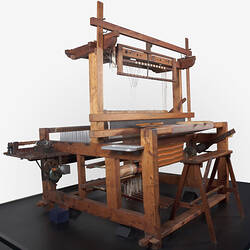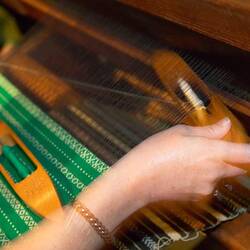Summary
Wooden shuttle used by Anita Apinis for weaving displays on the countermarch floor loom, while it was on display at the Immigration Museum (1998-2010). Anita is a second generation Latvian weaver, taught by her mother Anna and then undertook further training at the Melbourne College of Textiles. Anita's parents, Anna and Ervins, migrated to Australia in 1950, after spending time in a displaced persons camp Memmingin in Germany following World War Two. Anna had learnt to weave in Latvia and continued weaving in Australia, becoming one of the few suppliers of Latvian national costumes in the 1950s and 1960s, and exhibited her weaving nationally, at exhibitions and Latvian cultural festivals. She fulfilled her dream to keep her cultural traditions alive through her daughter Anita who continues to weave to this day.
Physical Description
Wooden shuttle used for weaving. The shuttle is smooth and has pointed ends. A metal rod passes through the wide hole in the centre of the shuttle. Another hole in the side of the shuttle permits thread to pass out of the shuttle and unravel when slid across the shed the space made between the warp threads.
Significance
Significance: These items form part of the Apinis Latvian weaving collection, a collection of Latvian weavings, tools (including a countermarch floor loom), weaving notebooks, costume items and audio visual interviews. Its historical and cultural significance lies in the comprehensive documentation of the story through artefacts and narratives, the quality of the weavings and the rarity of particular items such as the loom created in a German displaced persons' camp after World War II and notebooks kept from the 1930s to preserve traditional Latvian weaving techniques. The collection documents the maintenance and transportation of cultural traditions.
More Information
-
Collection Names
-
Collecting Areas
-
Acquisition Information
Donation from Mrs Anita Apinis-Herman, Jun 2010
-
User
Mrs Anita Apinis-Herman, Melbourne, Victoria, Australia, 1998-2010
-
Place & Date Used
Immigration Museum, Museum Victoria, Flinders Street, Melbourne, Greater Melbourne, Victoria, Australia, 2005-2010
-
Classification
-
Category
-
Discipline
-
Type of item
-
Keywords
Clothing Accessories, Cultural Identity, Displaced Persons, Handcrafts, Immigration, Latvian Communities, Latvian Immigration, Refugees, Displaced Persons Camps



